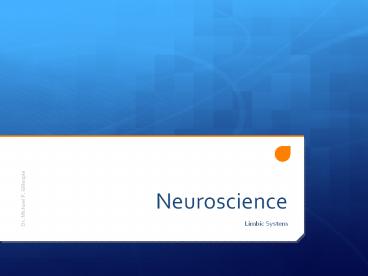Neuroscience - PowerPoint PPT Presentation
Title:
Neuroscience
Description:
Dr. Michael P. Gillespie Neuroscience Limbic System Limbic System The limbic system is located deep within the core of the brain. It is a source of our raw emotions ... – PowerPoint PPT presentation
Number of Views:257
Avg rating:3.0/5.0
Title: Neuroscience
1
Neuroscience
- Limbic System
2
Limbic System
- The limbic system is located deep within the core
of the brain. - It is a source of our raw emotions before they
are modulated by our frontal lobes. - It is a storehouse for long-term memories,
particularly memories that have a strong
emotional component.
3
Parts of the Limbic System
- Hippocampus
- Amygdalae
- Anterior thalamic nuclei
- Septum
- Limbic cortex
- Fornix
4
Functions of the Limbic System
- Emotion
- Behavior
- Motivation
- Long-term memory
- Olfaction
5
Functions
- The limbic system includes the hypothalamus,
amygdala, and the hippocampus. - These structures are involved in motivation,
emotion, learning, and memory. - The limbic system is where the subcortical
structures meet the cerebral cortex. - The limbic system operates by influencing the
endocrine system and the autonomic nervous system.
6
Functions continued
- The limbic system is highly interconnected with
the nucleus accumbens, which is the brains
pleasure center. - It plays a role in sexual arousal and the high
derived from certain recreational drugs. - The basal ganglia in the limbic system direct
intentional movements. This region also controls
posture and movement.
7
Limbic
- limbic comes from the Latin limbus for border
or edge. - The limbic system forms the inner border of the
cortex.
8
Hippocampus and Associated Structures
- Hippocampus
- Amygdala
- Fornix
- Mammillary body
9
Hippocampus
- Formation of long-term memories.
- Cognitive maps for navigation.
- If the hippocampus is damaged, a person cannot
build new memories.
10
Amygdala
- Signals the cortex of motivationally significant
stimuli related to reward and fear. - Participates in social functions such as mating.
- Stimulates the hippocampus to remember details
surrounding an event or situation.
11
Fornix
- Carries signals from the hippocampus to the
mammillary bodies and septal nuclei.
12
Mammillary Body
- Important for the formation of memory.
13
Septal Nuclei
- Interconnections between areas of the limbic
system. - Pleasure zone in animals.
14
Limbic Node
- Parahippocampal gyrus
- Formation of spatial memory
- Cingulate gyrus
- Autonomic functions
- Heart rate, blood pressure
- Cognitive and attentional processing
- Dentate gyrus
- Helps to formulate new memories
15
Additional Limbic Structures
- Entorhinnal cortex
- Memory and associative components
- Piriform cortex
- Olfactory system
- Fornicate gyrus
- Encompasses the cingulate, hippocampus, and
parahippocampal gyrus - Nucleus accumbens
- Involved in reward, pleasure, and addiction
- Orbitofrontal cortex
- Required for decision making































